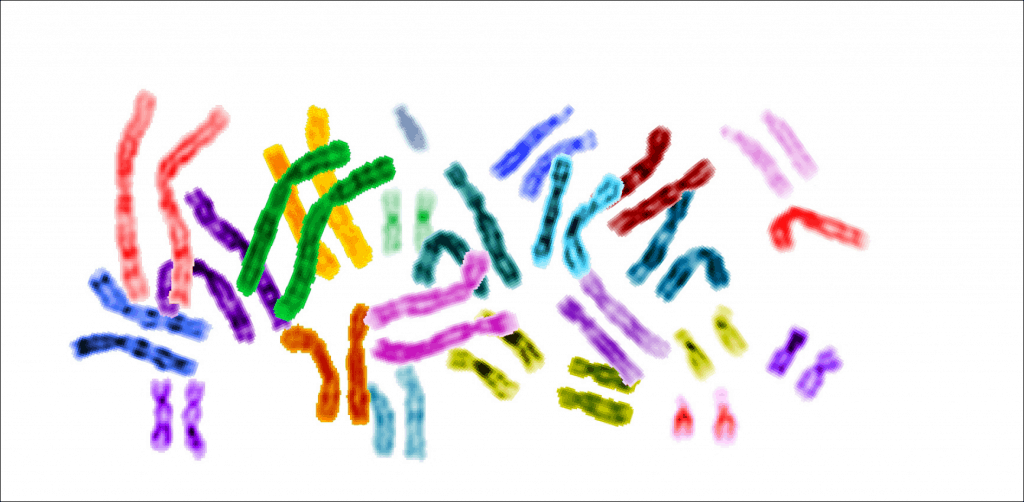Contents
Chromosomal abnormalities are a very common cause of spontaneous miscarriage. Most commonly a child with a chromosomal abnormality will not survive to birth. However, there are many cases where the child will survive, although often they have severe disability in life.
- The normal rate of miscarriage in the general population is 15%. Miscarriage does not become statistically significant unless one particular woman has >3 instances.
- Another common cause of miscarriage is a balanced translocation in one parent
Chromosome facts
- 15-20% of all pregnancies end in miscarriage – 50% of these cases are a result of chromosomal abnormality.
- 10% of sperm have a chromosome abnormality
- 25% of oocytes have a chromosomal abnormality
- Only around 1% of live births has a chromosomal abnormality
- This is about 5% in still births
Definitions
- Aneuploidy – an inappropriate number of chromosomes/copies of one particular chromosome (can be greater or fewer than normal)
- Trisomy – the existence of 3 copies of a particular chromosome
Types of chromosome
Submetacentric – these are chromosomes with a long arm and a short arm
Acrocentric – these are chromosomes with only long arm. On the other side of the centromere are ‘satellites’ that contain little genetic information, usually related to the production of ribosomes. This genetic info is generally repeated elsewhere in the genome and is not fundamental.
Reciprocal Translocations
Balanced Reciprocal Translocations
- 1 in 500 people has a balanced reciprocal translocation.
- Typically, cases are unique to a particular family, but a balanced translocation with chromosomes 11 and 22 is also a common occurrence.
- Reciprocal translocations can often only be identified with FISH, particularly if the broken segments are of equal length.
Unbalanced reciprocal translocations
At meiosis, a balanced reciprocal translocation may not be able to pair up correctly. Instead of paring in ‘two’s’ with the other same number chromosome, the balanced translocation ends up pairing in fours; known as a pachytene quadrivalent. In such a situation, all the genetic material matches up with its opposing genetic material, but because each chromosome has information from 2 chromosomes, they group in a four:
- Developmental delay
- Learning difficulties
- Congenital defects
Robertsonian Translocations
- Robertsonian translocations can occur in any of the acrocentric chromosomes. These are the chromosomes that have a long arm and no short arm, and include numbers 13, 14, 15, 21 and 22.
- In a Robertsonian Translocation, the satellites are lost, and the long arm of one chromosome fuses with the long arm of another acrocentric chromosome. This reduces the total number of chromosomes to 45.
- The satellites code for ribosomal RNA, but so do the satellites on all acrocentric chromosomes, so in a Robertsonian translocation, there is little genetic significance – unless the translocation affects meiosis.
- Robertsonian translocations occur in 1 in 1000 individuals in the general population, and usually the long arms of 13 and 14 fuse, to create 13q14q.
- Down’s syndrome is the major clinical effect of robertsonian translocations. Other effects that occur as a result of meiosis in the presence of a robertsonian translocation will either result in a balanced translocation with no clinical effects, or monosomy / trisomy of any of the acrocentric chromosomes, which will result in miscarriage.
Deletions
- DiGeorge’s Syndrome – widely varying clinical effects even with familial cases. Results in congenital defects, typically cleft lip and palate, congenital heart problems and sometimes also learning difficulties. There may also be a weakened immune response.
- Due to a deletion at 22q11.
- William’s Syndrome – again may result in learning difficulties, although individuals are often cheerful, and very friendly, especially to strangers. May have abnormal facial appearance.
- Due to a deletion at 7q11
- Cri du chat syndrome – so called due to the meow like cry that babies with this condition are affected with. Children may also have difficulty feeding and talking (due to small pharynx and larynx) as well as developmental problems.
- Due to a deletion on chromosome 5p
